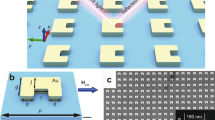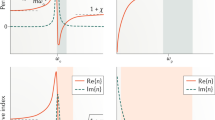Abstract
Metamaterials offer unprecedented flexibility for manipulating the optical properties of matter, including the ability to access negative index1,2,3,4, ultrahigh index5 and chiral optical properties6,7,8. Recently, metamaterials with near-zero refractive index have attracted much attention9,10,11,12,13. Light inside such materials experiences no spatial phase change and extremely large phase velocity, properties that can be applied for realizing directional emission14,15,16, tunnelling waveguides17, large-area single-mode devices18 and electromagnetic cloaks19. However, at optical frequencies, the previously demonstrated zero- or negative-refractive-index metamaterials have required the use of metallic inclusions, leading to large ohmic loss, a serious impediment to device applications20,21. Here, we experimentally demonstrate an impedance-matched zero-index metamaterial at optical frequencies based on purely dielectric constituents. Formed from stacked silicon-rod unit cells, the metamaterial has a nearly isotropic low-index response for transverse-magnetic polarized light, leading to angular selectivity of transmission and directive emission from quantum dots placed within the material.
This is a preview of subscription content, access via your institution
Access options
Subscribe to this journal
Receive 12 print issues and online access
$209.00 per year
only $17.42 per issue
Buy this article
- Purchase on Springer Link
- Instant access to full article PDF
Prices may be subject to local taxes which are calculated during checkout





Similar content being viewed by others
References
Shelby, R. A., Smith, D. R. & Schultz, S. Experimental verification of a negative index of refraction. Science 292, 77–79 (2001).
Zhang, S. et al. Experimental demonstration of near-infrared negative-index metamaterials. Phys. Rev. Lett. 95, 137404 (2005).
Shalaev, V. M. et al. Negative index of refraction in optical metamaterials. Opt. Lett. 30, 3356–3358 (2005).
Valentine, J. et al. Three-dimensional optical metamaterial with a negative refractive index. Nature 455, 376–379 (2008).
Choi, M. et al. A terahertz metamaterial with unnaturally high refractive index. Nature 470, 369–373 (2011).
Decker, M., Klein, M. W., Wegener, M. & Linden, S. Circular dichroism of planar chiral magnetic metamaterials. Opt. Lett. 32, 856–858 (2007).
Plum, E., Fedotov, V. A., Schwanecke, A. S., Zheludev, N. I. & Chen, Y. Giant optical gyrotropy due to electromagnetic coupling. Appl. Phys. Lett. 90, 223113 (2007).
Zhang, S. et al. Negative refractive index in chiral metamaterials. Phys. Rev. Lett. 102, 023901 (2009).
Liu, R. et al. Experimental demonstration of electromagnetic tunneling through an epsilon-near-zero metamaterial at microwave frequencies. Phys. Rev. Lett. 100, 023903 (2008).
Huang, X., Lai, Y., Hang, Z. H., Zheng, H. & Chan, C. T. Dirac cones induced by accidental degeneracy in photonic crystals and zero-refractive-index materials. Nature Mater. 10, 582–586 (2011).
Yun, S. et al. Low-loss impedance-matched optical metamaterials with zero-phase delay. ACS Nano 6, 4475–4482 (2012).
Vesseur, E., Coenen, T., Caglayan, H., Engheta, N. & Polman, A. Experimental verification of n = 0 structures for visible light. Phys. Rev. Lett. 110, 013902 (2013).
Adams, D. et al. Funneling light through a subwavelength aperture with epsilon-near-zero materials. Phys. Rev. Lett. 107, 133901 (2011).
Enoch, S., Tayeb, G., Sabouroux, P., Guérin, N. & Vincent, P. A metamaterial for directive emission. Phys. Rev. Lett. 89, 213902 (2002).
Ziolkowski, R. Propagation in and scattering from a matched metamaterial having a zero index of refraction. Phys. Rev. E 70, 046608 (2004).
Alù, A. Silveirinha, M., Salandrino, A. & Engheta, N. Epsilon-near-zero metamaterials and electromagnetic sources: tailoring the radiation phase pattern. Phys. Rev. B 75, 155410 (2007).
Silveirinha, M. & Engheta, N. Tunneling of electromagnetic energy through subwavelength channels and bends using ɛ-near-zero materials. Phys. Rev. Lett. 97, 157403 (2006).
Bravo-Abad, J., Joannopoulos, J. D. & Soljačić, M. Enabling single-mode behavior over large areas with photonic Dirac cones. Proc. Natl Acad. Sci. USA 109, 9761–9765 (2012).
Hao, J., Yan, W. & Qiu, M. Super-reflection and cloaking based on zero index metamaterial. Appl. Phys. Lett. 96, 101109 (2010).
Boltasseva, A. & Atwater, H. A. Low-loss plasmonic metamaterials. Science 331, 290–291 (2011).
Soukoulis, C. M. & Wegener, M. Past achievements and future challenges in the development of three-dimensional photonic metamaterials. Nature Photon. 5, 523–530 (2011).
Lewin, L. The electrical constants of a material loaded with spherical particles. Proc. Inst. Elec. Eng. Part 3 94, 65–68 (1947).
O'Brien, S. & Pendry, J. B. Photonic band-gap effects and magnetic activity in dielectric composites. J. Phys. Condens. Matter 14, 4035–4044 (2002).
Zhao, Q., Zhou, J., Zhang, F. & Lippens, D. Mie resonance-based dielectric metamaterials. Mater. Today 12, 60–69 (2009).
Zhao, Q. et al. Experimental demonstration of isotropic negative permeability in a three-dimensional dielectric composite. Phys. Rev. Lett. 101, 027402 (2008).
Kuznetsov, A. I., Miroshnichenko, A. E., Fu, Y. H., Zhang, J. & Luk'yanchuk, B. Magnetic light. Sci. Rep. 2, 492 (2012).
Shi, L., Tuzer, T. U., Fenollosa, R. & Meseguer, F. A new dielectric metamaterial building block with a strong magnetic response in the sub-1.5-micrometer region: silicon colloid nanocavities. Adv. Mater. 24, 5934–5938 (2012).
Peng, L. et al. Experimental observation of left-handed behavior in an array of standard dielectric resonators. Phys. Rev. Lett. 98, 157403 (2007).
Popa, B-I. & Cummer, S. Compact dielectric particles as a building block for low-loss magnetic metamaterials. Phys. Rev. Lett. 100, 207401 (2008).
Ginn, J. et al. Realizing optical magnetism from dielectric metamaterials. Phys. Rev. Lett. 108, 097402 (2012).
Novoselov, K. S. et al. Two-dimensional gas of massless Dirac fermions in graphene. Nature 438, 197–200 (2005).
Tsukerman, I. Effective parameters of metamaterials: a rigorous homogenization theory via Whitney interpolation. J. Opt. Soc. Am. B 28, 577–586 (2011).
Wu, Y., Li, J., Zhang, Z-Q. & Chan, C. Effective medium theory for magnetodielectric composites: beyond the long-wavelength limit. Phys. Rev. B 74, 085111 (2006).
Chen, X., Grzegorczyk, T. & Wu, B. Robust method to retrieve the constitutive effective parameters of metamaterials. Phys. Rev. E 70, 016608 (2004).
Smith, D. R., Vier, D. C., Koschny, T. & Soukoulis, C. M. Electromagnetic parameter retrieval from inhomogeneous metamaterials. Phys. Rev. E 71, 036617 (2005).
Acknowledgements
This work was funded by the Office of Naval Research (programmes N00014-11-1-0521 and N00014-12-1-0571) and the United States–Israel Binational Science Foundation (programme 2010460). A portion of this research was conducted at the Center for Nanophase Materials Sciences, which is sponsored at Oak Ridge National Laboratory by the Scientific User Facilities Division, Office of Basic Energy Sciences, US Department of Energy. The authors thank N. Lavrik for discussions regarding RIE processing.
Author information
Authors and Affiliations
Contributions
P.M. fabricated the metamaterials and both P.M. and Y.Y. conducted the numerical simulations and experimental characterization. Z.A. assisted in measuring transmission as a function of incident angle. I.I.K. assisted in developing the electron-beam lithography and RIE processes and D.P.B. performed the low-pressure chemical vapour deposition. The idea was developed by J.V., who assisted in all aspects of the work and supervised the project. All authors discussed the results and contributed to writing the manuscript.
Corresponding author
Ethics declarations
Competing interests
The authors declare no competing financial interests.
Supplementary information
Supplementary information
Supplementary information (PDF 1196 kb)
Rights and permissions
About this article
Cite this article
Moitra, P., Yang, Y., Anderson, Z. et al. Realization of an all-dielectric zero-index optical metamaterial. Nature Photon 7, 791–795 (2013). https://doi.org/10.1038/nphoton.2013.214
Received:
Accepted:
Published:
Issue Date:
DOI: https://doi.org/10.1038/nphoton.2013.214
This article is cited by
-
High-permittivity ceramics enabled highly homogeneous zero-index metamaterials for high-directivity antennas and beyond
eLight (2024)
-
Toroidal Dipole All-Dielectric Metasurfaces with High Sensitivity, High Figure of Merit, and Robustness for Refractive Index Sensing
Journal of Electronic Materials (2024)
-
Tailoring the resonant modes in liquid crystal based all-dielectric metasurfaces
Scientific Reports (2023)
-
Triple-band metamaterial perfect absorber for refractive index sensing in THz frequency
Optical and Quantum Electronics (2023)
-
Conformal optical black hole for cavity
eLight (2022)



